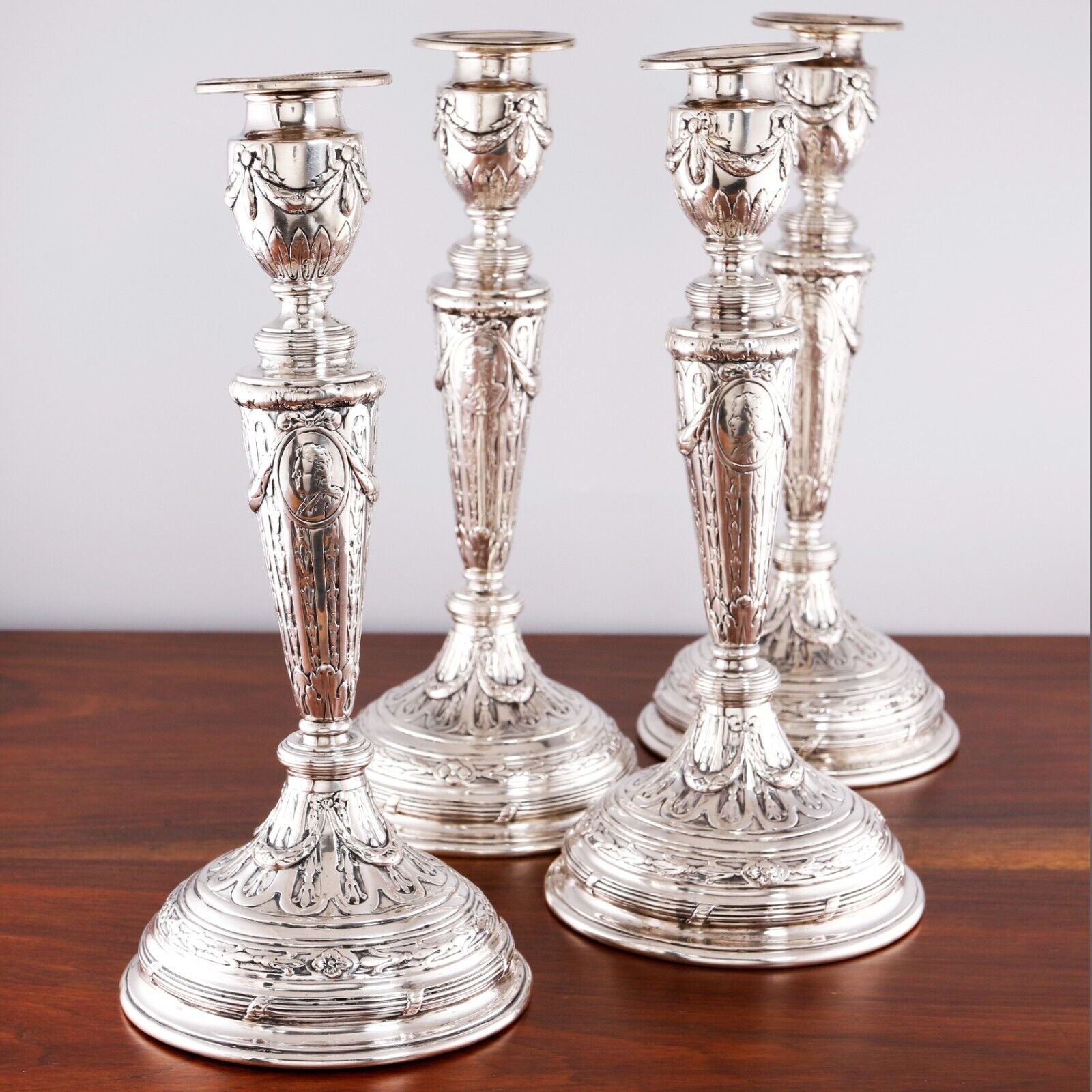-40%
Antique Neoclassical Hawksworth & Eyre Sterling Silver Candlesticks Provenance
$ 844.8
- Description
- Size Guide
Description
Pair of impressive heavy 3.21 Lb. ea weighted, 11" tall Neoclassical sterling silver candlesticks. Made by Hawsworth & Erye & Co. LTD. of Sheffield England, 1901 (date mark).Detachable beaded and concave bobeche. Fully marked on their bases and inside bobeche ...see photos . There are some minor pings on the stepped bases from use. Wonderful provenance... from the estate of a prominent Massachusetts family (see below). They have not been polished probably in quite some time, so showing the tarnish and patina of age. Will leave that up to the buyer who may want to have them polished professionally, or leave them as is.
Dimensions: H 11 1/4 x W 4 3/4 square . Weighted. Each weigh 1465.5 grams (3.21 lb each )
The provenance of the candlesticks follows...For those of you who are always interested to know where your antique purchases came from, they are from an estate with and interesting provenance...
PROVENANCE
These Hawksworth & Eyre candlesticks were among a large collection of fine items (many dating back to the 1800s and as far back as the late 1700s) — passed down from the estate of prominent noted American economist, entrepreneur and philanthropist Roger Ward Babson (1875-1967) to his family.
Roger was a tenth generation Gloucester Massachusetts Babson who’s earliest American relative, Isabel Babson (a midwife) arrived with her sons in Salem Mass in 1637.
Many items in Roger Babson’s estate were documented to have come directly to the Babson family from preceding family members... some of who were generations of sea captains based out of Gloucester. They imported Chinese export and items from England and the continent to America in the late 1700s and early to mid 1800s. Some items were also from a collection of American antiques and paintings owned by Babson’s wealthy grandson, Roger Babson Webber who owned antique and book shops in the 1960s-80s on Beacon Hill, Boston and in the nearby town of New Boston MA., where he passed away in 1984. The items were then passed to his sisters.
There is much information about the Babson family heritage and pioneer economist (M.I.T. GRADUATE) Roger Babson (1875-1967) on the web.
Roger accomplished much during his lifetime including: founding of Babson College in 1919, and founding of Weber College in 1927 (now Weber International University). Earlier in his career as an economist, Babson founded the Business Statistical Organization in 1904, selling business and investment information to companies. Roger Babson earned the distinction of being the first financial forecaster to predict the stock market crash of October, 1929. From 1910 to 1923, he commented on business and other matters as a regular columnist for the Saturday Evening Post. He also contributed weekly columns for the New York Times and for the newspapers owned by the Scripps Syndicate. Babson eventually formed his own syndicate, the Publishers Financial Bureau, to disseminate his writings to papers across the United States. Over the course of 33 years, he wrote 47 books, including his autobiography. He was 1940 candidate for US presidency for the Prohibition Party coming in third behind Franklin Roosevelt and Wendell Wilkey (it was noted in a local Wellesley Mass Column dated 1957 that Babson and his grandaughter, Camilla entertained Mrs. Eleanor Roosevelt at luncheon in Mr. Babson’s winter home in Mountain Lake, Fla.) In 1948 he founded the Gravity Research Foundation. He felt that gravity waves should somehow be harnessed, and that this important force of nature was not being properly exploited. Roger Babson extended his interest in the public’s welfare beyond investment counseling. He encouraged industries to develop products to improve public health and safety. Among businesses receiving Roger Babson’s approval and financial backing were select early manufacturers of sanitary paper towels and other hygienic products, fire alarm call boxes, fire sprinklers, and traffic signals.
There is much more information to be found on the Babson and Weber College websites regarding the life of Roger W. Babson.
The one aspect of Roger Babson’s studies at M.I.T. (1895-1898) that he valued throughout his life was learning about the British scientist, mathematician, and philosopher, Isaac Newton.
Roger Babson was impressed by Newton’s discoveries, especially his third law of motion--”For every action there is an equal and opposite reaction.” He eventually incorporated Newton’s theory into many of his personal and business endeavors.
Another interesting note: Roger’s first wife, Grace Margaret Knight accumulated the largest collection of Newtonia (artifacts, documents and works of Sir Issac Newton, the person who most influenced the life of her husband) in the United States.THE NEWTON COLLECTION WAS PURCHASED BY MASSACHUSETTS INSTITUTE OF TECHNOLOGY IN MA. AND IS NOW ON EXHIBIT THERE.




















